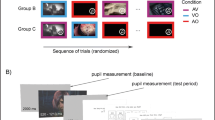Abstract
In an experiment exploring the impact of sound on sensations of telepresence, 126 participants watched a video clip using either headphones or speakers. The results illustrate that sound is an important factor in stimulating telepresence responses in audiences. Interactions between soundscape and screen size were also revealed. A traverse interaction between aural/visual congruency and soundscapes was evident. A second data set of 102 participants was collected to illuminate the effect of technological expectation that emerged in the first study. Expectations had been mentioned in other studies, and the data support the notion that people have an expectation of the technological quality of a presentation. The results suggest that examining expectations could assist in future conceptualizations of telepresence.


Similar content being viewed by others
Explore related subjects
Discover the latest articles, news and stories from top researchers in related subjects.Notes
Please note that Study 2 only examined technological expectations (not content), so social realism was not tested.
Scheffe post hoc shows all mean pairs with Better than Expected are different.
References
Annaud JJ (1981) Quest for fire [Motion Picture]. International Cinema Corporation (ICC), France
Besmer F (1983) Horses, musicians, and gods: the Hausa cult of possession-trance. Bergen & Garvey, South Hadley, MA
Blesser B, Salter LR (2007a) Spaces speak, are you listening? Experiencing aural architecture. The MIT Press, Cambridge, MA
Blesser B, Salter LR (2007b) Working vocabulary for the experience of aural architecture. Retrieved February 17, 2008, from http://www.blesser.net/downloads/Glossary.pdf
Bracken CC (2005) Presence and image quality: the case of high definition television. Media Psychol 7:191–205
Bracken CC (2006) Perceived source credibility of local television news: the impact of image quality and presence. J Broadcast Electron 50:723–741
Bracken CC, Pettey G, Rubenking B, Guha T (2008) Sounding out small screens and telepresence: the impact of screen size, pace & sound. Presented to the Information Processing division of the International Communication Association annual convention in Montreal, Quebec, Canada
Deeprose C, Andrade J, Varma S, Edwards N (2004) Unconscious learning during surgery with propofol anaesthesia. Br J Anaesth 92:171–177
Freeman J (2004) Implications for the measurement of presence from convergent evidence on the structure of presence. Paper presented to the Information Systems Division at the annual meeting of the International Communication Association, New Orleans, LA
Hall E (1966) The hidden dimension. Doubleday, New York
Heeter C (1992) Being there: the subjective experience of presence. Presence Teleop Virt Environ 1(2):262–271
Heeter C (2003) Reflections on real presence by a virtual person. Presence Teleop Virt Environ 12(4):335–345
Ivory JD, Kalyanaraman S (2007) The effects of technological advancement and violent content in video games on players’ feelings of presence, involvement, physiological arousal, and aggression. J Commun 57:532–555
Izard CE (1972) Patterns of emotions: a new analysis of anxiety and depression. Academic Press, New York
Izard CE (1977) Human emotions. Plenum Press, New York
Izard CE, Dougherty FE, Bloxom BM, Kotsch NE (1974) The differential emotions scale: a method of measuring the subjective experience of discrete emotions. Vanderbilt University Press, Nashville, TN
Kallinen K, Ravaja N (2007) Comparing speakers versus headphones in listening to news from a computer—individual difference and psychophysiological responses. Comput Hum Behav 23:303–317
Kim T, Biocca F (1997) Telepresence via television: two dimensions of telepresence may have different connections to memory and persuasion. J Comput Med Commun 3(2)
Larsson P, Vastfjall D, Olsson P, Kleiner M (2007) When what you hear is what you see: presence and auditory-visual integration in virtual environments. Paper presented at the 10th annual international workshop on presence, Barcelona, Spain
Le Groux S, Jonatas Manzolli J, Verschure P (2007) Interactive sonification of the spatial behavior of human and synthetic characters in a mixed-reality environment. P10 Ann Int Worksh
Lee KM (2004) Presence, explicated. Commun Theory 14:27–50
Lombard M (2000) Resources for the study of presence: presence explication. Retrieved February 28, from http://www.temple.edu/ispr/frame_explicat.htm
Lombard M (2008) Presence and telepresence scholarship: challenges ahead. Paper presented to the “When Media Becomes Reality Workshop”, Berne, Switzerland
Lombard M, Ditton T (1997) At the heart of it all: the concept of presence. J Comput Med Commun 13:573–590
Lombard M, Ditton T, Weinstein L (2009) Measuring telepresence: the temple presence inventory. Paper presented to the twelfth annual international confernce of the presence workshop, Los Angeles, CA, USA
Nunez D (2007) Effects of non-diegetic information on presence: a content manipulation experiment. P10 Ann Int Worksh
Pettey G, Bracken CC, Rubenking B, Appley E, Brown M, Butler D, Cline K, Coralic Z, Hargiti J, Liou H (2008) No vision is complete without sound*: the sonification of telepresence. In: Proceedings of the eleventh annual international meeting of the presence workshop, Padova, Italy, 38–45
Portas C, Krakow K, Allen P, Josephs O, Armony J, Frith C (2000) Auditory processing across the sleep-wake cycle simultaneous EEG and fMRI monitoring in humans. Neuron 28:991–999
Rattenborg NC, Lima SL, Amlaner CJ (1999) Half-awake to the risk of predation. Nature 397:397–398
Rouget G (1985) Music and trance: a theory of the relations between music and possession (trans: Biebuyck B). University of Chicago Press, Chicago
Skalski P, Tamborini R (2007) The role of social presence in interactive agent-based persuasion. Media Psychol 10:385–413
Tajadura-Jimenez A, Vajamae A, Kitagawa N, Ho HN (2007) Whole-body vibration influences sound localization in the median plane. P10 Ann Int Worksh
Thayer R (1989) The biopsychology of mood and arousal. Oxford University Press, New York
THX (2009a) HDTV buying tips from THX. Retrieved April 1, 2009 from http://www.thx.com/products/home/displays/shopping.html
THX (2009b) THX certified cinema. Retrieved April 1, 2009 from (http://www.thx.com/cinema/index.html)
Witmer BG, Singer MJ (1998) Measuring presence in virtual environments: a presence questionnaire. Presence Teleop Virtual Environ 7:225–240
Author information
Authors and Affiliations
Corresponding author
Rights and permissions
About this article
Cite this article
Pettey, G., Bracken, C.C., Rubenking, B. et al. Telepresence, soundscapes and technological expectation: putting the observer into the equation. Virtual Reality 14, 15–25 (2010). https://doi.org/10.1007/s10055-009-0148-8
Received:
Accepted:
Published:
Issue Date:
DOI: https://doi.org/10.1007/s10055-009-0148-8




